Abstract
The paper examines the features of innovation activity of the business sector in the Russian Federation. The problems of innovative development of small and medium-sized businesses are identified. The analysis of various approaches to the formation of innovation development policies shows that according to most authors the national economic efficiency can be increased through focus on search, implementation and introduction of innovations, that is, on innovative development, since there is a direct correlation between the competitive advantages of the system and its ability to introduce innovations. The study of the features of innovation processes showed that the state should fulfil regulatory functions of the innovation process with respect to social criteria, which sometimes become crucial, since research and innovation activities discover new opportunities for improving the efficiency of not only small and medium-sized businesses, but also socio-economic development of society. The analysis of the current policy of innovative development in Russia revealed the specifics of the state policy of innovative development and the problems of innovative development of small and medium-sized businesses in Russia. Despite the existence of various mechanisms for state regulation of innovation development, in practice, the situation is somewhat different. State authorities are trying to delegate the maximum number of functions to the market as the most effective mechanism capable of self-regulation. At the same time, in highly developed countries, it is the state that takes significant responsibility for innovative development.
Keywords: Entrepreneurshipinnovationsmall and medium-sized businessgovernment control
Introduction
The development of innovation activities of small and medium-sized enterprises is one of the most important factors to increase the level of economic competitiveness and national security of the state. The global experience shows that the states that have an effective innovation infrastructure are at the forefront in terms of technological and socio-economic development.
When borrowing a system of institutions – regulators of economic processes – national and regional specifics should be considered. The infrastructure of innovative entrepreneurship in Russia should be reformed not only through a system of state support based on foreign experience, but also based on real prerequisites for competitive activity of enterprises – subjects of innovative entrepreneurship in Russia emerged at various stages of their development, primarily during evolutionary transformation of institutional structures into centers for the commercialization of innovations.
Problem Statement
To date, numerous publications are devoted to the problems of innovative development. Among Russian scientists, Baklanov (2016), Gorbas (2015) and others made a significant contribution to the issues of innovative development of the country. These authors emphasize, in particular, the need for transition to an innovative model of economic growth, emphasize ineffectiveness of innovation policy in the Russian Federation, and focus on mechanisms to ensure the country’s innovative growth.
The formation of the institutional support of the innovation infrastructure development in the Russian Federation is one of the most crucial problems of the domestic economy.
Research Questions
The object of the analysis of functioning of the infrastructure for innovative entrepreneurship is the Russian Federation.
Purpose of the Study
The study aims to identify current problems of innovative development of small and medium-sized businesses in the Russian Federation.
Research Methods
The research methods include the analysis of the selected sources related to the problem under consideration, generalization and synthesis of viewpoints in the sources, and method of retrospective and comparative analysis.
Findings
Intensification of innovation activity requires new forms and methods for technological innovation primarily through expansion of the innovation market. It should be noted that among the countries of the European Union, the minimum indicators of innovation activity are found for Portugal – 26% and Greece – 29%, however, even these figures are higher than those identified for Russia. Compared to the leading countries such as Austria (67%), Germany (69%), Denmark (71%) and Ireland (74%), the gap with Russia is 3–4 fold times greater (Baklanov, 2016).
The factors that largely impede implementation of innovation activity are (Figure
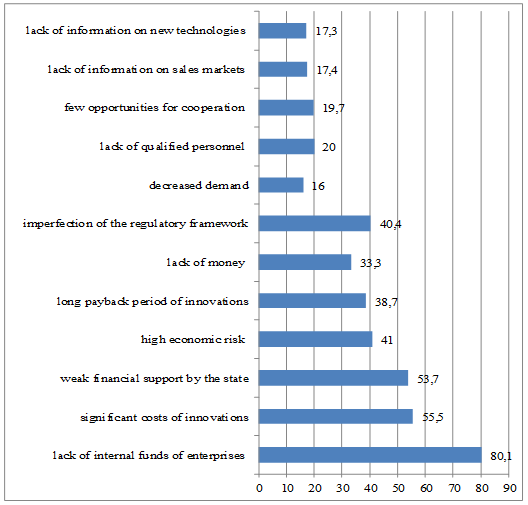
The dynamic analysis of the share of organizations that implement technological, organizational and marketing innovations in the total number of surveyed organizations of small and medium-sized enterprises in Russia for 2010–2016 showed the peak of innovation activity for 2011, when the studied indicator attained 10.4%. Subsequently, it was observed to decrease to 9.3%. In turn, the decline in innovation activity of small and medium-sized enterprises resulted in reduction in the share of innovative goods, works and services.
This indicator showed the tendency to grow from 2010 (4.8%) to 2013 (9.2%), but in 2017 it decreased to 8.4%. According to the constructed trend line, the share of innovatively active small and medium-sized enterprises tends to reduce in the future with a probability of 99.3% (Figure
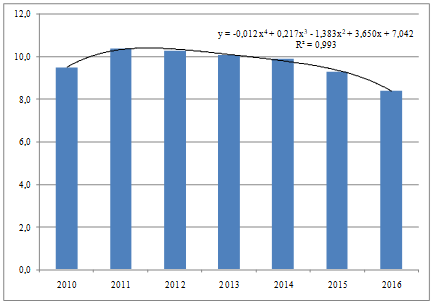
The current situation is due to a number of factors that have a negative impact on the innovation sphere of the Russian Federation.
1. Insufficient financing of innovation activities of small and medium-sized businesses. This is evidenced by the share of R&D expenditures in the gross domestic product stated by the ranking of national R&D expenditures. Thus, in 2015 Russia occupied the 27th position between Slovakia and Lithuania and exhibited the share of R&D expenditures equal to 1.13%. At the same time, the leaders in this rank were Israel and South Korea, whose share of R&D expenditures in GDP is 4.27% and 4.23%, respectively. It should be noted that the USA occupied the 9th position (2.79%), China took the 14th position (2.07 %), and Germany was at the 8th position (2.88%) (Figure
It should be taken into account that the average indicator among developed countries reached 2.46%, and among developing countries it was equal to 1.20%. Thus, the share of Russian R&D expenditures in GDP is lower than the average share in developing countries (Figure
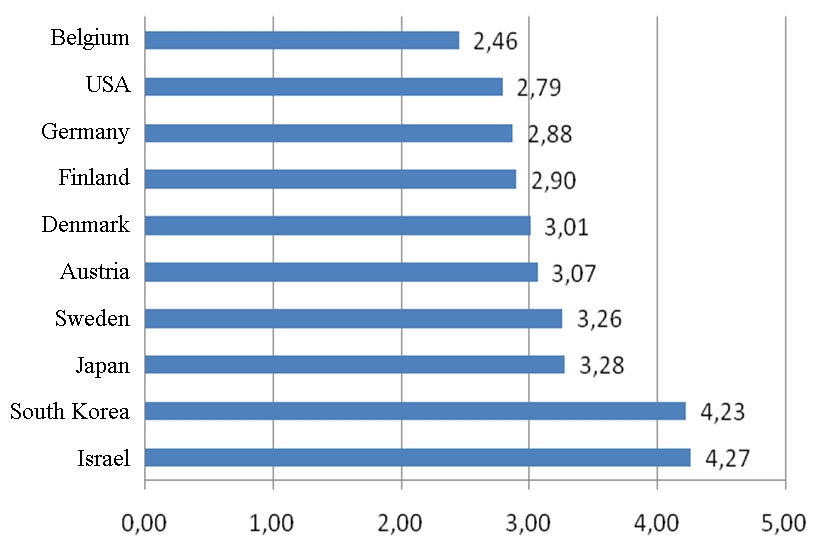
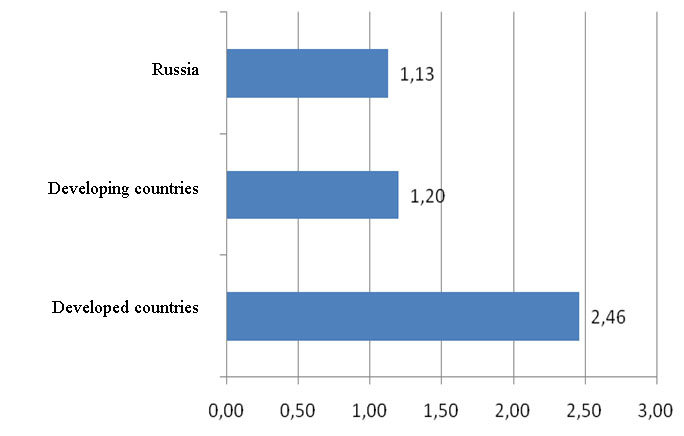
2. From 2010 to 2014, innovation expenditures increased 3-fold (in 2014, it equaled 1,211,897.1 mln rub). However, in 2015, the analyzed indicator decreased by 0.05% compared to the previous period of study. This is most likely due to the crisis in the economy of the Russian Federation.
Even though the volume of innovation expenditures has grown (Figure
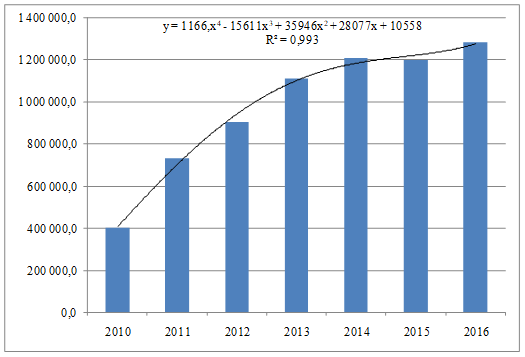
3. The number of personnel of small and medium-sized enterprises engaged in research and development decreased.
This indicator was observed to grow in the period of 2000–2016 from 369,015 people in 2013 to 379,411 people in 2015 (RosStat, 2015; RosStat, 2016). However, in 2016 it dropped to 370,379 people, and according to the constructed trend line, the number of personnel engaged in research and development tends to reduce in the future with a probability of 98.7% (Figure
4. The share of small enterprises that performed technological innovations in the total number of small enterprises surveyed in terms of the type of economic activity indicates a decline in innovative entrepreneurship in small businesses (Figure
This is due to the fact that small businesses face difficulties in innovation promotion: these are political and economic instability and an undeveloped innovation infrastructure (Baklanov, 2016).
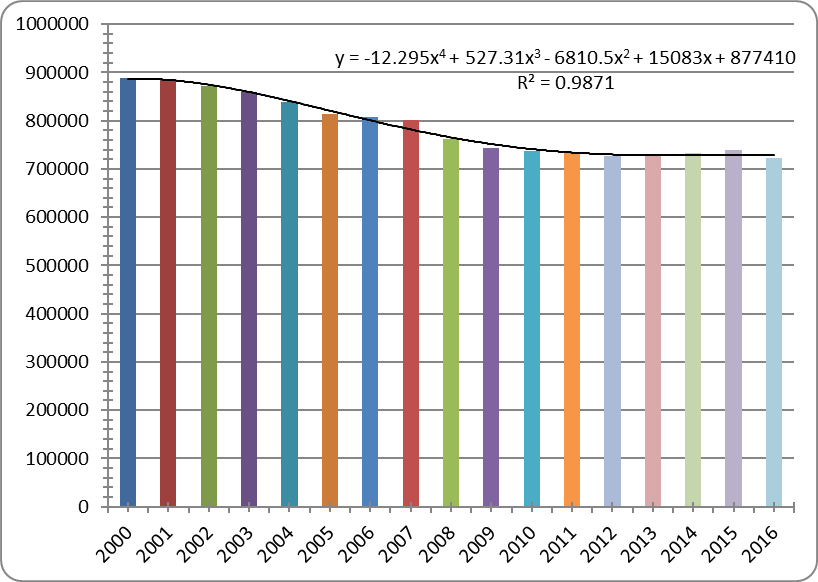
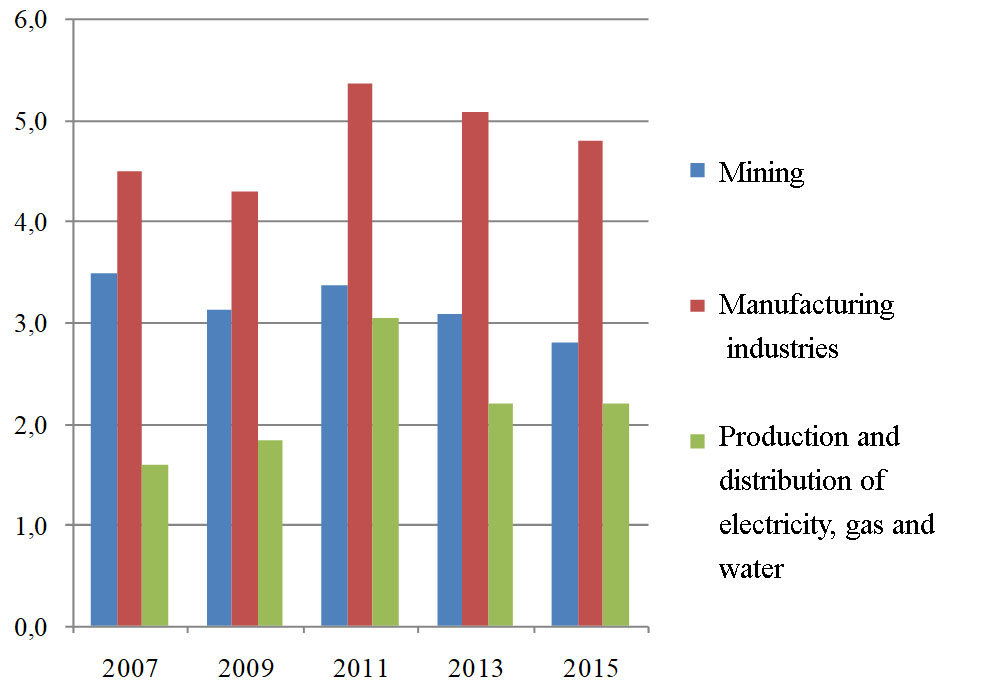
5. Russia is characterized by a low level of scientific and technological potential implementation and insufficient use of knowledge for socio-economic development in the concept of knowledge economy (Baklanov, 2016).
Innovative foundations for economic growth can be formed only on a system basis, that is, taking into account all factors of their interaction. Information technology should be used to identify priority areas for innovation involving all segments of society to create a highly efficient and dynamic national economy.
Conclusion
Economic instability increases business risks: sharp fluctuations in the ruble exchange rate against other currencies, an increased cost of raw materials and other resources, etc., lead to higher expenditures for domestic business. Violations of the normal functioning of capital affect not only enterprises, but also the general economic situation in the country.
For example, it is well known that a significant share of the capital, which should have been allocated to the maintenance and modernization of the OPF, provides, among other things, personal income of the owners. As a result, small groups of people own an inordinate amount of money. This causes noticeable imbalance in the consumer market. Significant amounts of resources are spent to earn super-profits, whereas incomes of other people are not appropriately used (this is especially evident in the unsatisfied proposal of social housing), and the money are stored up.
The lack of investment in the production reduces the demand for new equipment and new technologies. This hinders the development of domestic high-tech production. The problem of insufficient financing of innovative development is most acute. The search and development of measures to form and expand the economic base for innovative development is extremely relevant.
References
- Baklanov, A.O. (2016). Identification of Facts Affecting the Results of Innovation Activities in Industrialized Countries. INEKEKONA Bulletin, 2(11), 24–35.
- Gorbas, I. M. (2015). Innovative component of the socio-economic development of the country. Formation of Market Relations, 12(55), 59–62.
- RosStat (2015). Federal State Statistics Service. Retrieved from: https://www.gks.ru/announcements/document/62781
- RosStat (2016). Federal State Statistics Service. Retrieved from: http://www.gks.ru/wps/wcm/connect/rosstat_main/ rosstat/ru/statistics/science_and_innovations/science/#
- UNESCO (2015). UIS Statistics. Retrieved from: http://data.uis.unesco.org/#
Copyright information

This work is licensed under a Creative Commons Attribution-NonCommercial-NoDerivatives 4.0 International License.
About this article
Publication Date
28 December 2019
Article Doi
eBook ISBN
978-1-80296-075-4
Publisher
Future Academy
Volume
76
Print ISBN (optional)
-
Edition Number
1st Edition
Pages
1-3763
Subjects
Sociolinguistics, linguistics, semantics, discourse analysis, science, technology, society
Cite this article as:
Tavbulatova*, Z., Visaitova, M., Vahabova, M., & Bataeva, P. (2019). Trends Of Development Of Businesses Enterprises In The Russian Federation. In D. Karim-Sultanovich Bataev, S. Aidievich Gapurov, A. Dogievich Osmaev, V. Khumaidovich Akaev, L. Musaevna Idigova, M. Rukmanovich Ovhadov, A. Ruslanovich Salgiriev, & M. Muslamovna Betilmerzaeva (Eds.), Social and Cultural Transformations in the Context of Modern Globalism, vol 76. European Proceedings of Social and Behavioural Sciences (pp. 3094-3101). Future Academy. https://doi.org/10.15405/epsbs.2019.12.04.417
